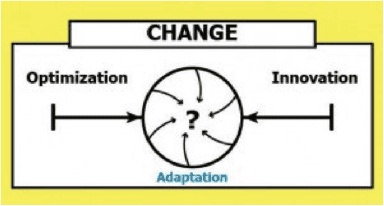Paradox … some ‘thing’ that is constructed by individuals when oppositional tendencies
are brought into recognizable proximity through reflections or interaction. Ford & Backoff

Paradoxes or contradictions emerge when our beliefs or assumptions fail to keep up with external changes (Cannon, 1996: 110). A classic example is the paradox of value aka the diamond-water paradox in which water, necessary for survival, is priced considerably lower than diamonds.
Earlier this year, I wrote a series of nine blogs depicting contemporary paradoxes near and dear to our capacity to learn and organize effectively — motivation, information, culture, change, consciousness, learning, conflict, ecology, and the economy. The internal tension that arises while one is confronted by a paradox expands proportionately when challenged with nine of these opposing tendencies, which is a common occurrence in today’s workplaces. These increased levels of tension are also evidenced by the global escalation of stress-related mental illness as reported by the World Health Organization.
According to Marianne Lewis (2000), such paradoxes activate our egos, which in turn defensively reinforce cycles of:
1. Splitting – further polarizing into “we” and “they” distinctions or subgroups
2. Projection – transferring the contradiction to others
3. Repression – denial or blocking of awareness
4. Regression – resorting to what has provided security in the past
5. Reaction formation – reacting with what is opposite to the threat
6. Ambivalence – compromising conflicting emotions with lukewarm reactions
In today’s complex organizational environment, instead of attempting to rationally resolve these paradoxes, choosing to live within their opposing tensions brings forth insight and creative change. The resolution process is one of exploring rather than suppressing these tensions. Sitting with tension as a means of understanding its contradictions, rather than defending against them, is itself a new change paradigm for most people and requires new behaviours:
- Acceptance – awareness of and living with paradoxical tension
- Confrontation – reflection and discussion to create new understanding
- Transformation – reframing personal assumptions and beliefs about the paradox, which then alter its meaning from opposing to complementary
An example of such complementarity exists when one considers the present paradox apparent in organizational change. Competitive advantage in today’s marketplace requires organizations to both optimize their operations and innovate their products and services.
Optimization and innovation are no longer ‘either/or’ choices and become complementary forces when the organization learns to adapt its systems and structures to accommodate ‘both/and’ possibilities. Instead of the traditional hierarchy of a top-down pyramid structure, the enterprise transforms itself into a vertically-integrated decentralized organization (top-down and bottom-up network) through its acceptance, confrontation and sense-making of paradox.
How comfortable is your organization with this tension between optimizing and innovating?
I am collecting organizational stories (anonymous and confidential) about any of the nine paradoxes referred to above. If you submit your organization’s story depicting its experience with one or many of these paradoxes, I will reciprocate with one FREE hour of either leadership coaching or organizational design and development.
Sources:
Cannon, T. B. 1996. Welcome to the Revolution: Managing Paradox in the 21st Century. London: Pitman.
Ford, J. D. & R. W. Backoff. 1988. Organizational Change in and out of Dualities and Paradox. In R. E. Quinn & K. S. Cameron (Eds.), Paradox and Transformation: Toward a Theory of Change in Organizations and Management: 81-121. Cambridge, MA: Ballinger.
Lewis, Marianne W. 2000. Exploring Paradox: Toward a more comprehensive guide. Academy of Management Review, Vol. 25-4, 760-776.
STS-RT Discovery Team. 2011. “Designing the Adaptive Enterprise.” Presentation at New Orleans Annual Meeting, September.





